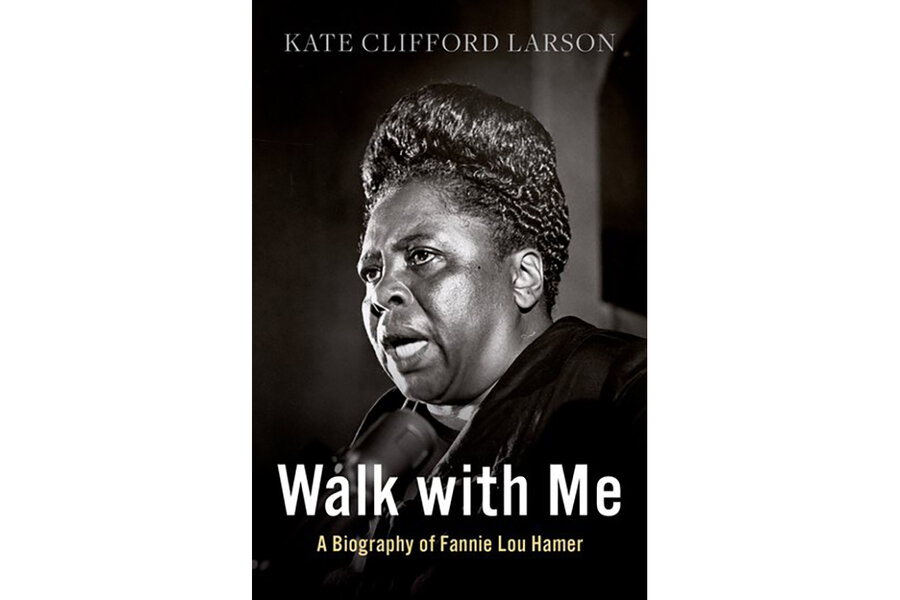A leader of the civil rights movement that you’ve never heard of
Loading...
Fannie Lou Hamer had been letting her light shine ever since her father put her on the table to sing the gospel song “This Little Light of Mine” as a child, but as a Black woman in Mississippi during Jim Crow, much of the world didn’t see her value.
Kate Clifford Larson’s book “Walk With Me: A Biography of Fannie Lou Hamer” brings her story and eventual emergence as a civil rights leader into view, providing a fresh look at the oft-repeated stories of the civil rights movement.
Fannie Lou Hamer is not Martin Luther King Jr., and perhaps that is the point. Without the pedigree and polish of King, Hamer, who picked 200 to 300 pounds of cotton a week as a teenager, also emerged as a leader. How she came to the national spotlight is equally as compelling as the power of her voice.
Most of the country viewed Mississippi in the early 1960s as an undesirable place mired in a racial morass. The state had 50 lynchings of African Americans just decades earlier. The late Bob Moses looked at the state’s poor, Black farmers and saw potential.
“The leadership is there,” Moses told an audience. “If you go out and work with your people, then the leadership will emerge.... We don’t know who they are now: we don’t need to know. But the leadership will emerge.”
The title of Larson’s biography is apt, “Walk With Me.” The Harvard-educated Moses did just that after leaving his job as a math teacher in New York in his 20s to work in the South registering voters. It was the locals like Hamer who had to walk the walk.
After attempting to register to vote in 1962, Hamer lost her job and home. She left town, only to return after realizing that organizers like Moses represented the beginning of a “New Kingdom right here on earth.” The young people, according to Hamer, gave “the hope that we prayed for so many years.”
In the summer of 1961, few civil rights workers went into Mississippi where Moses went, but by tapping into wells of wisdom like Hamer and Amzie Moore, who knew local concerns, Moses helped bring the nation’s focus to the struggle in Mississippi.
“Freedom Summer,” the organizing effort of Moses, Hamer, and others, brought hundreds of college students to Mississippi from across the country to register voters in 1964. The resulting integrated Mississippi Freedom Democratic Party went to that summer’s Democratic National Convention with the hopes of being recognized as the state’s legitimate Democratic Party.
Hamer testified on behalf of the newly formed party at the convention in front of a live national television audience. In three years, the former schoolteacher Moses and the former sharecropper Hamer went from the fields of Mississippi to the cusp of national politics and power.
With Southern officials threatening to pull their support for President Lyndon Johnson’s nomination if the integrated party was seated, the president held an impromptu press conference to interrupt Hamer during her testimony. Afterward, however, the networks aired her speech, in which she described shootings, imprisonment, and beatings.
“All of this is on account of we want to register, to become first-class citizens,” Hamer concluded. “If the Freedom Democratic Party is not seated now, I question America. Is this America, the land of the free and the home of the brave, where we have to sleep with our telephones off the hooks because our lives be threatened daily, because we want to live as decent human beings, in America?”
The nation was stunned. “Martin Luther King or the SNCC field secretaries, they couldn’t do what Fannie Lou Hamer did,” Moses said in a later interview. “They couldn’t be a sharecropper and express what it meant, and that’s what Fannie Lou Hamer did.”
Larsen provides insights into Hamer’s life, but also into the White House politicking that occurred before the party was offered two seats at the convention instead of the full 68.
The compromise was rejected. “We didn’t come all this way for no two seats,” Hamer told a reporter. The biography tells her story, underscores her stand for principle, and clarifies what “all this way” for her really meant. In doing so, the book also illuminates Moses and his vision of leadership, which involved cultivating that quality in others.
While the party, including Hamer, was seated at the convention four years later, her question, “Is this America?” stands out decades later. Larson’s biography provides needed context for understanding that moment. The book’s emergence now also shows that sometimes it takes time for the value of something to come to light.









